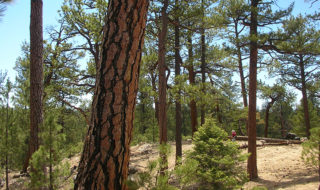
An example of a mixed-conifer forest in the Sierra de San Pedro Martir National Forest, Baja California Norte, Mexico. This forest experienced active, natural fires until the 1970s. (Photo by Carrie Levine).
Until recently, the consensus among forest ecologists was that before European settlers arrived in the Sierra, the forests were mostly open conifer forests dominated by big trees and low-to-moderately severe fires every eight to 12 years. The Forest Service recently released a plan to restore the range's forests back to this state following decades of fire suppression and timber harvesting regulations, which have created dense, fire-prone forests.
But recent studies, using a newly developed methodology, have argued that the Sierra Nevada was actually a more dense forest than the consensus view. These new studies were used to back a lawsuit to stop the agency's plan to restore Sierra forests following the 2013 Rim Fire. The Berkeley study refutes the conclusions of these studies and identifies flaws in their methods.
“We went through the data and showed that, in every case, this method estimated that the density of trees was two to three times higher than was the reality,” said Carrie Levine, a Ph.D. student of forest ecology at Berkeley and lead author of the study.
The study was recently published online in the journal Ecological Applications. Berkeley professors John Battles and Scott Stephens and research scientist Brandon Collins were co-authors on the publication. Also involved in the study were researchers from Harvard Forest, the USDA Forest Service Pacific Southwest Research Station, the University of Montana, Utah State University, University of California, Davis, and the USDA Forest Service Pacific Southwest Region.

An example of a densified mixed-conifer forest in the Plumas National Forest in Northern California. Fires have been suppressed in this forest for more than 100 years. (Photo by Carrie Levine).
When the U.S. was divvying up land in the West in the late 19th and early 20th centuries, the General Land Office performed surveys so that the land could be parceled and sold. Land was divided into square-mile blocks, with markers used to indicate every corner point. In case a marker was moved, so-called “witness trees” near the stake were identified as reference points. The result of this data is a grid survey of the entire American West.
Using this historic field data, two ecologists at the University of Wyoming, Mark Williams and William Baker, developed a method that claims to calculate the area that a tree occupies, which is then used to calculate a forest's density. This approach is based on the observation that trees create space to keep other trees from cramming next to them, and that this space correlates to a tree's species and size.
To assess the validity of this area-based method of density estimation in the Sierra Nevada, Levine and her co-authors assembled data from plots of mapped trees across the Sierra and Baja California, Mexico. They tested the performance of the area-based method in these mapped stands where the true density was known.
Levine and colleagues found that the area-based method has two basic flaws when applied to the Sierra, the most notable being an inability to actually predict the area that a tree occupies based on its species and size due to a weak relationship between these variables. The other flaw was a failure to account for differences in the number of trees sampled at each corner. The methodological flaws led to an inflated number of trees estimated in a pre-European Sierra Nevada forest, Levine and colleagues argue.
“We have a mapped plot where every tree is measured, so we know the true density,” Levine said.
The study is important not only for the current state of the Sierra Nevada, but for its future.
“As climate changes, we want to have an accurate understanding of the past. This allows us to manage for forests that are resilient to the changes we're expecting in the future,” Levine said.